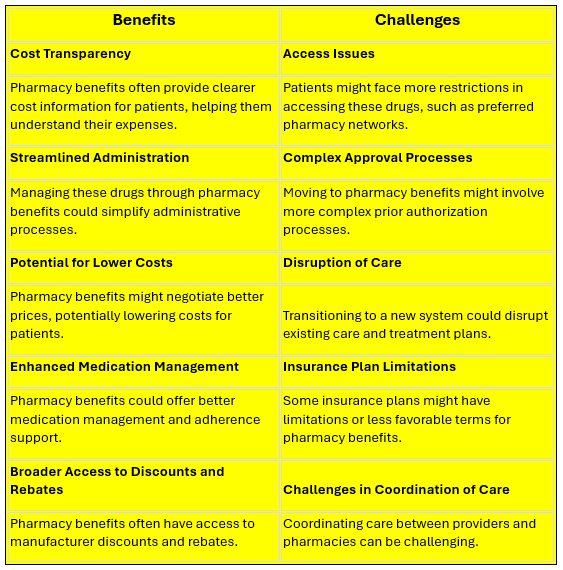The healthcare landscape is constantly evolving, and one notable change that’s garnering attention is the shift of J-code drugs to pharmacy benefits. This shift has wide-ranging implications for patients, healthcare providers, and insurers alike. In this post, we delve into the benefits and challenges of this move, offering a balanced perspective that is essential for stakeholders in the healthcare industry.
Understanding J-Code Drugs
Before we dive into the specifics, let’s clarify what J-code drugs are. These are typically injectable drugs administered in a physician’s office. They are categorized under ‘J-codes’ in the Healthcare Common Procedure Coding System (HCPCS). These drugs have traditionally been covered under medical benefits but are increasingly being moved to pharmacy benefits.
The Shift to Pharmacy Benefits: Benefits and Challenges
Benefits of the Shift
- Cost Transparency: Pharmacy benefits often come with clearer cost information, making it easier for patients to understand and manage their expenses.
- Streamlined Administration: This transition can simplify administrative processes, potentially reducing the paperwork and time involved in drug dispensing.
- Potential for Lower Costs: Through pharmacy benefits, there might be better negotiation leverage for prices, potentially leading to lower costs for patients.
- Enhanced Medication Management: Pharmacy benefits could offer better support in medication management, ensuring adherence and improving patient outcomes.
- Broader Access to Discounts and Rebates: Patients might benefit from discounts and rebates that are more readily available through pharmacy benefits.
Challenges of the Shift
- Access Issues: Patients might face more restrictions, such as limited networks of preferred pharmacies, impacting their access to necessary medications.
- Complex Approval Processes: The transition might involve more complex prior authorization processes, potentially delaying treatment.
- Disruption of Care: Switching systems could disrupt existing care plans, causing inconvenience and potential health risks for patients.
- Insurance Plan Limitations: Some insurance plans might offer less favorable terms for pharmacy benefits, impacting coverage and costs.
- Challenges in Coordination of Care: Coordinating care between healthcare providers and pharmacies can be complex and time-consuming.
J-code drugs are typically injectable drugs that are administered primarily in a physician’s office. Moving these to the pharmacy benefit could have several implications. Here’s a table that outlines some potential benefits and challenges:

Implications for Stakeholders
For Patients
Patients need to be aware of how this shift could affect their access to medication and overall costs. Understanding the nuances of their insurance plans is more crucial than ever.
For Healthcare Providers
Providers must navigate the new administrative landscapes, ensuring that they can still deliver the best care while dealing with different billing and authorization processes.
For Insurers
Insurers play a critical role in this transition, balancing the need to manage costs while ensuring patient access to necessary treatments.
For Pharmacists
Pharmacists will likely see an increased role in patient care, requiring a deeper understanding of J-code drugs and associated management protocols.
Conclusion
The transition of J-code drugs to pharmacy benefits is a complex process with both benefits and challenges. It’s essential for all stakeholders to stay informed and adapt to these changes to ensure that patient care remains effective and efficient. As the healthcare industry continues to evolve, staying ahead of trends like this will be key to navigating the future of healthcare successfully.
